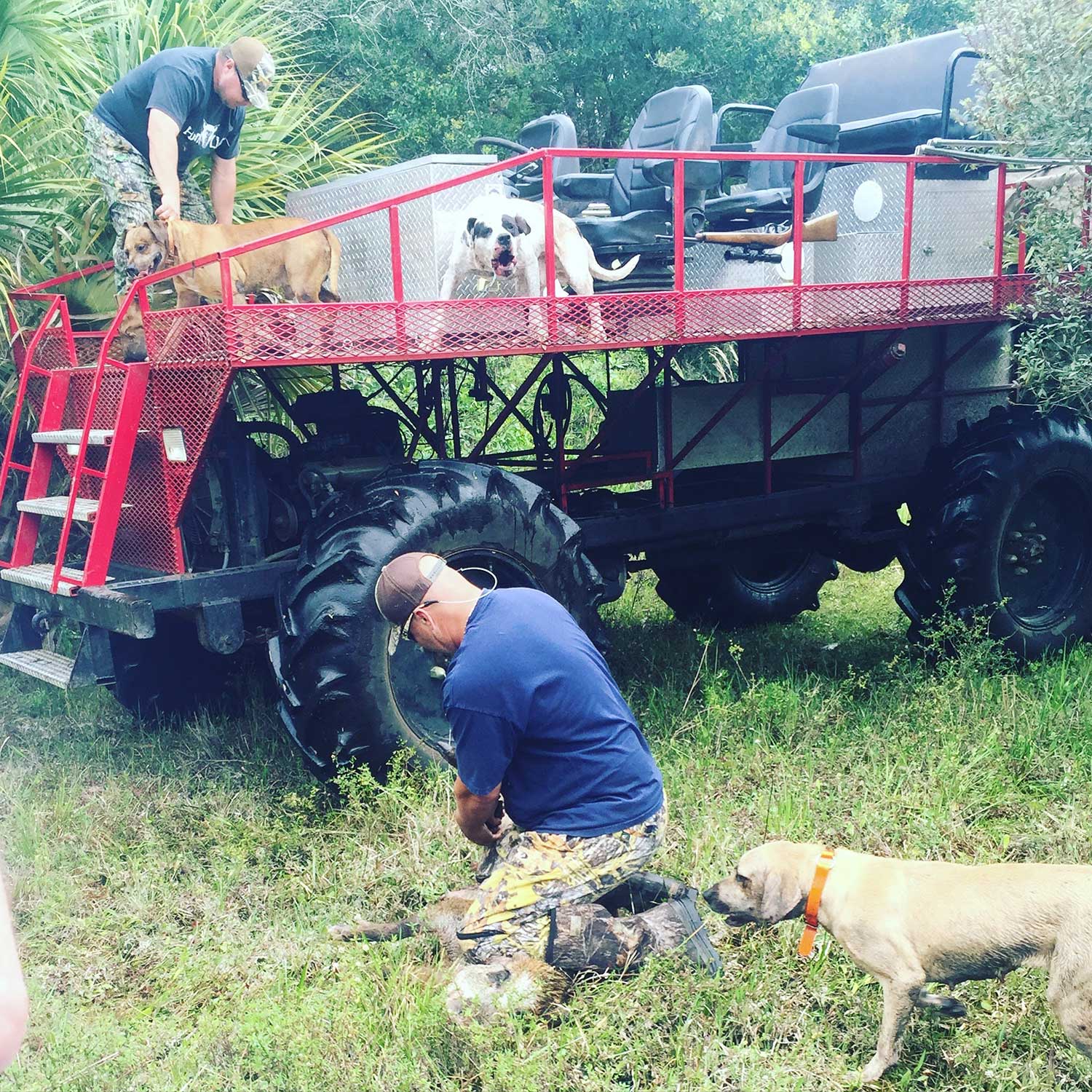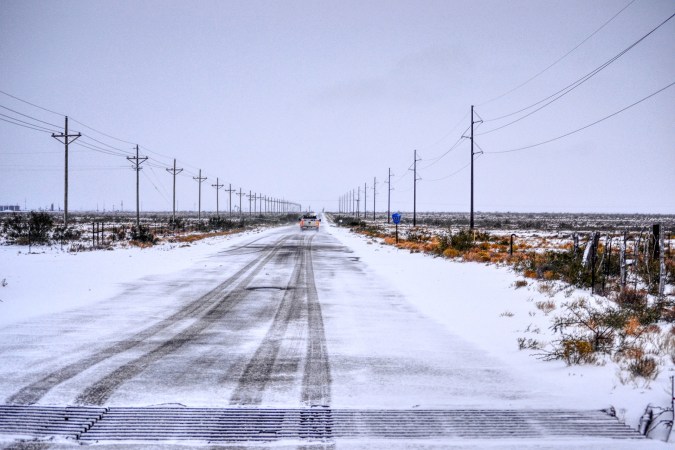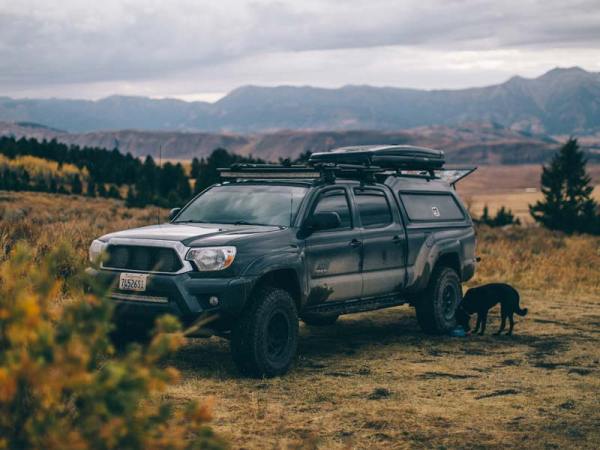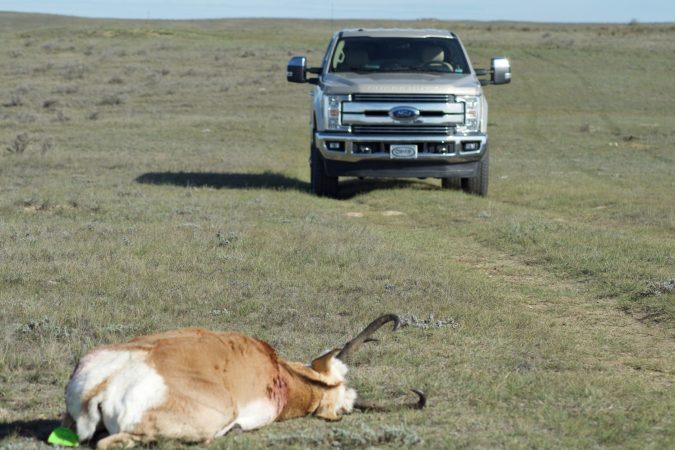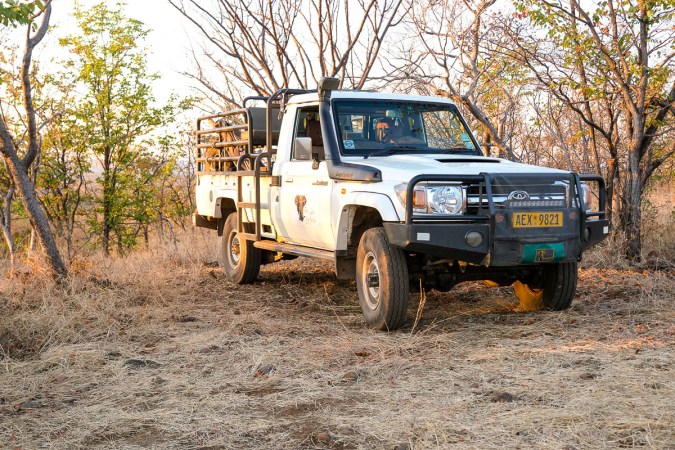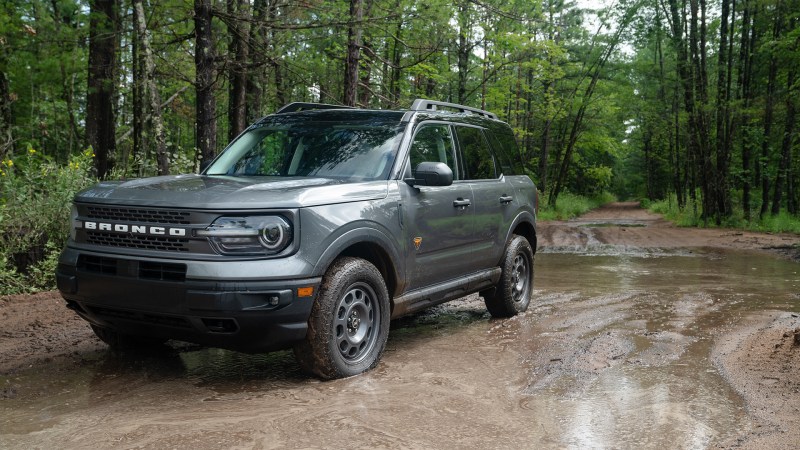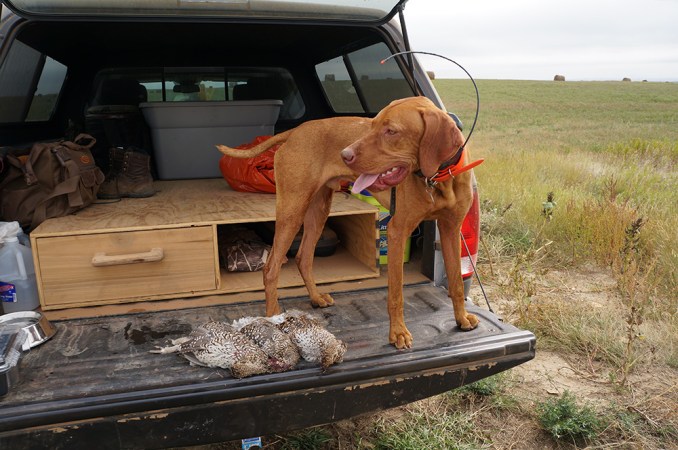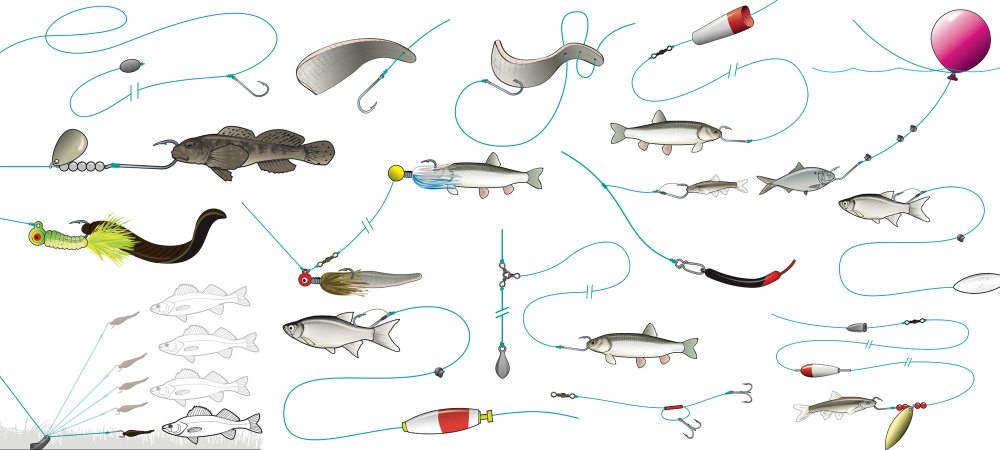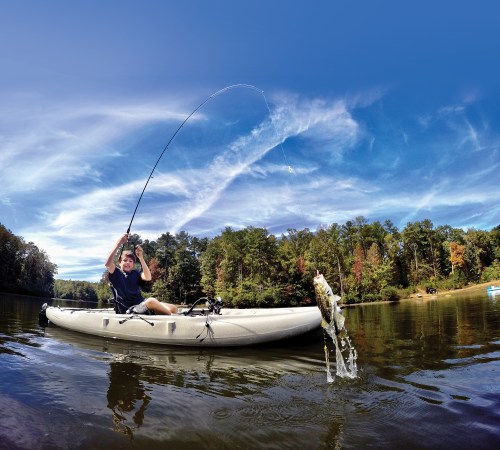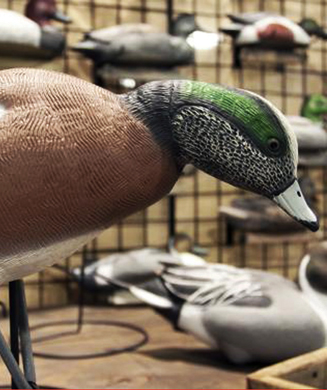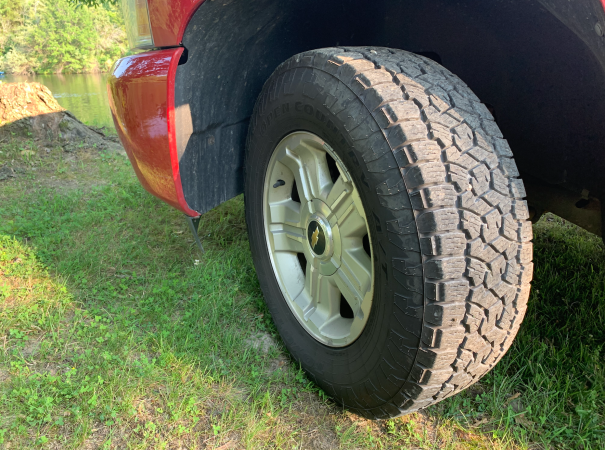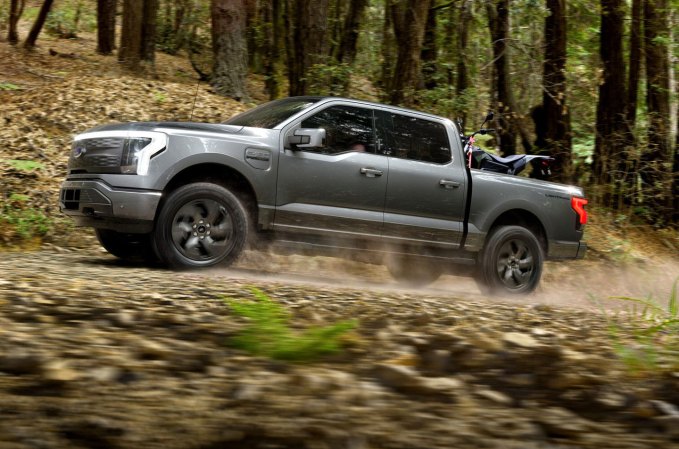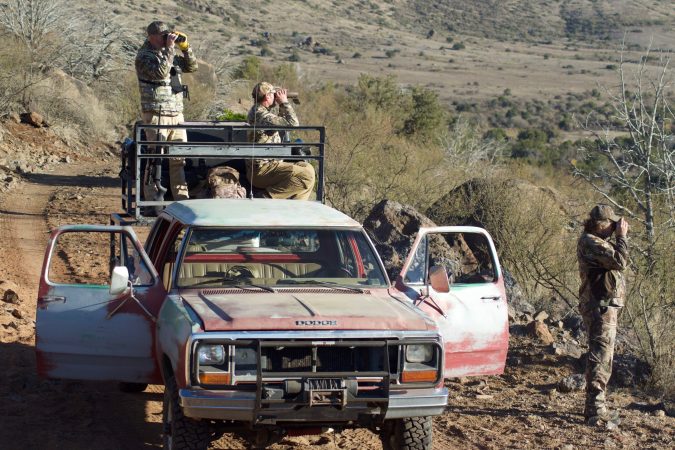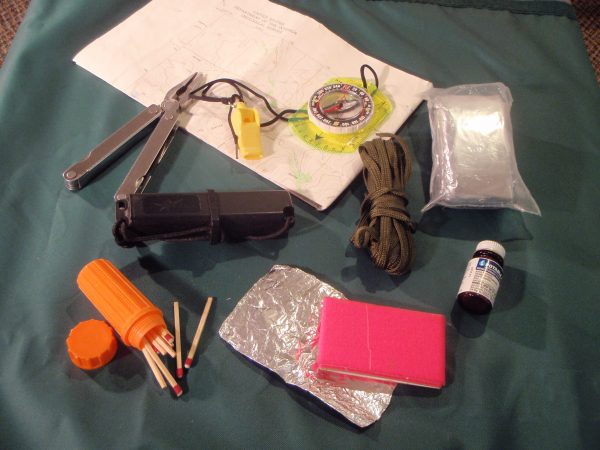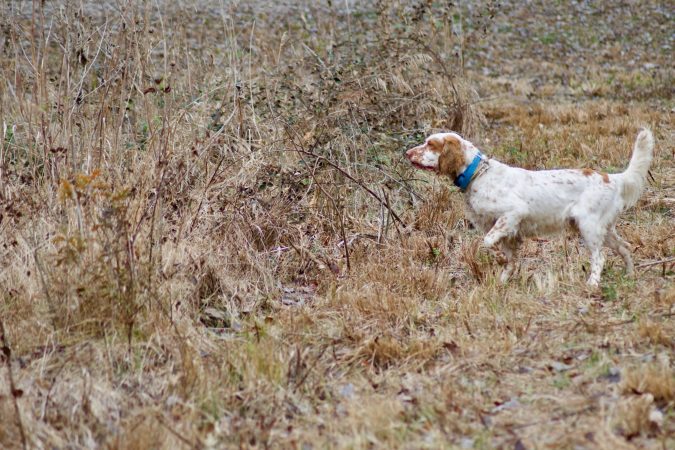We may earn revenue from the products available on this page and participate in affiliate programs. Learn More ›
My favorite hunting rig was a 1978 Jeep CJ5. I could remove the rear bench seat with a crescent wrench and easily fit two dog boxes to hold four dogs. I’d turn the manual hubs and run it in reverse to engage the four-wheel-drive, and when I did, I could climb any hill, ridge, or mountain with unparalleled maneuverability. That same rig towed my boat for sea duck hunts just as easily as it ran the fishing beaches. Everything was manual from the transmission to the choke and the heat. On hot days, I would remove the doors literally in two seconds and the top in about two minutes.
I’ll never forget the time when a fully restored, 1970, hunter green Barracuda pulled up next to me at the stop light. Its 198-cubic-inch, slant-six engine sounded more powerful than it really was, but the driver didn’t care. He was staring at my rig.
“Sweet Jeep,” he said.
“Wanna race?” I asked.
He laughed when I revved the engine on my inline four-banger, and when the light changed, that Barracuda was out of sight before I had shifted into third gear. Hunting rigs don’t need to go fast; they just need to go hard with purpose. We all dream of unique vehicles so here is a sample of some of the best.
Super Swamper
Stacy Howell of Naples, Florida has a rig that would make Mad Max drool. “I hunt hogs and whitetails in the woods next to cow pastures, through oak and pine hammocks and around cypress heads,” he says. “Our hunting area is just north of the Everglades, and that means that from June through November, we get a lot of rain. There’s usually so much water that even low-lying areas turn into seasonal ponds. To hunt hogs and deer in this kind of terrain, I needed a rig to run through soft dirt, mud, and water that’s 2-3 feet deep. And because we’re always in the water, I needed easy access to check for repairs.
“I started with a stripped down Chevy 350 engine and a 16-foot-long frame. Next, I added military-style axles for strength and durability and then built a steel frame with beams and risers. A simple, stainless steel deck sits on the frame, and it’s 5 1/2 feet off the ground. That height makes hog spotting easy in the thick understory. On each side of the railing are gun hooks for when we’re stopped, and I’ve got a secure gun rack for when we’re moving.
“I built a console, extended the steering column, and added four captains chairs and a bench seat in the back. Underneath the bench seat is a storage box, and below that are two dog boxes. All in I can carry seven hunters and four dogs. If we bring more dogs, I tether them to rings in the front of the console so they can catch a hog’s scent as we drive. The buggy is so much fun to drive that we’ll just take it out for joy rides in between hunting seasons.”
Alaskan Backcountry Buggy
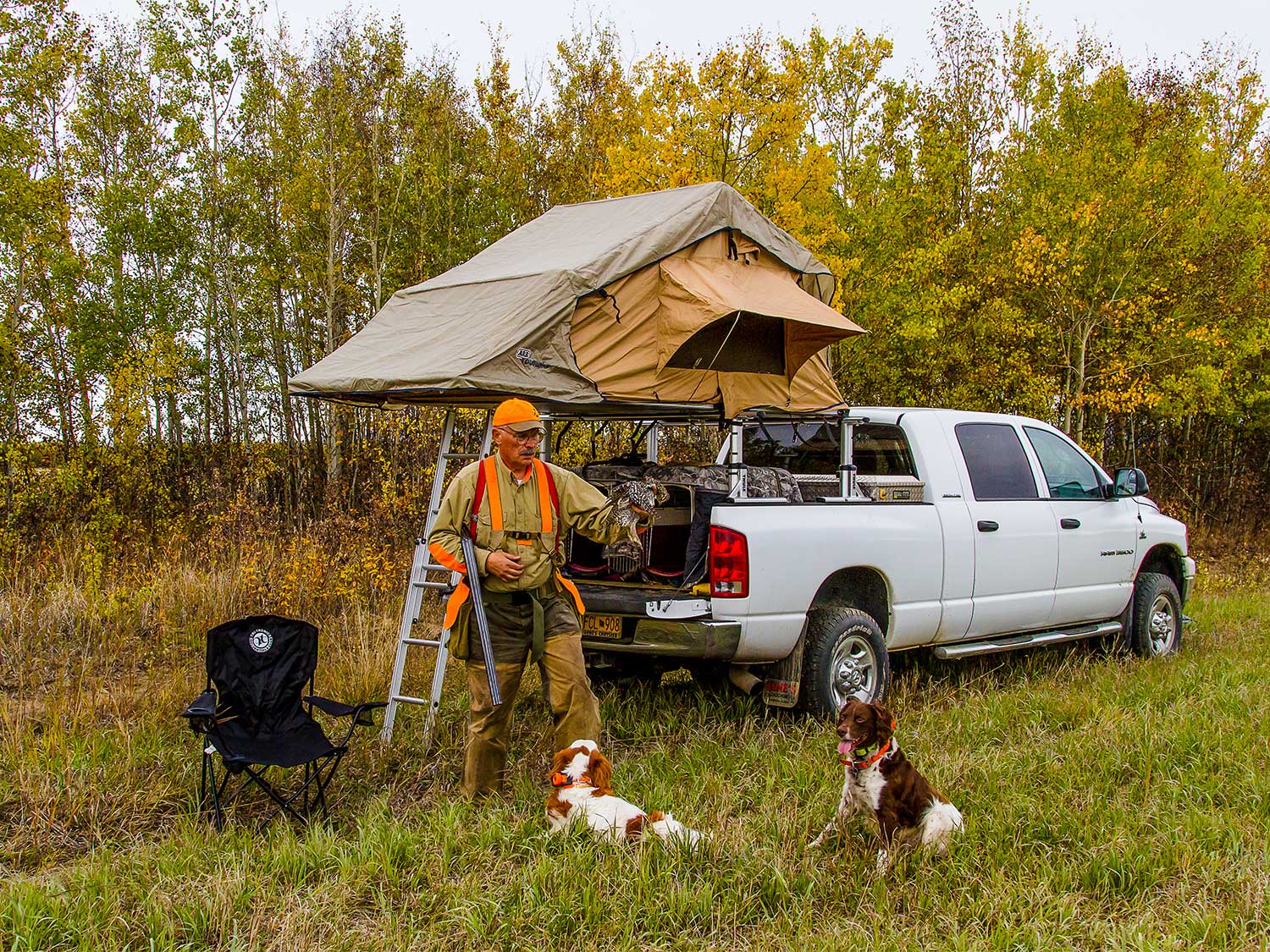
Since 1970, Jim McCann has logged a lot of miles around Alaska. McCann first ran the highways as a State Trooper, but as a hunter, he always probed the remote reaches of the interior. To secure content and images required by his second career as an award-winning outdoor writer, photographer, and author of the book Upland Hunting in Alaska, he routinely traveled deep into the backcountry. Since his kind of travel is extreme, a hunting rig can be the difference between life and death.
McCann has both a two-door and a four-door Jeep Wrangler Rubicon which he uses for trips to his favorite Ruffed grouse coverts. But when he grabs his recurve bow for a moose hunt above the Arctic Circle or loads up his string of britneys for late-winter ptarmigan, he’ll drive his Dodge 3500 Mega Cab. “I like my Dodge because it has excellent ground clearance and its Cummins diesel engine has power and fuel efficiency,” he says. “The back seat is enormous and easily handles my hunting gear, clothing, and a week’s worth of freeze-dried food. I added a custom aluminum box in the bed to store camping equipment, a selection of tools, firewood and potable water. In addition to safety gear, I pack two, fully-stocked first aid kits. One is for me, while the other is for my dogs. All in, I’ve basically got a small, mobile hospital.
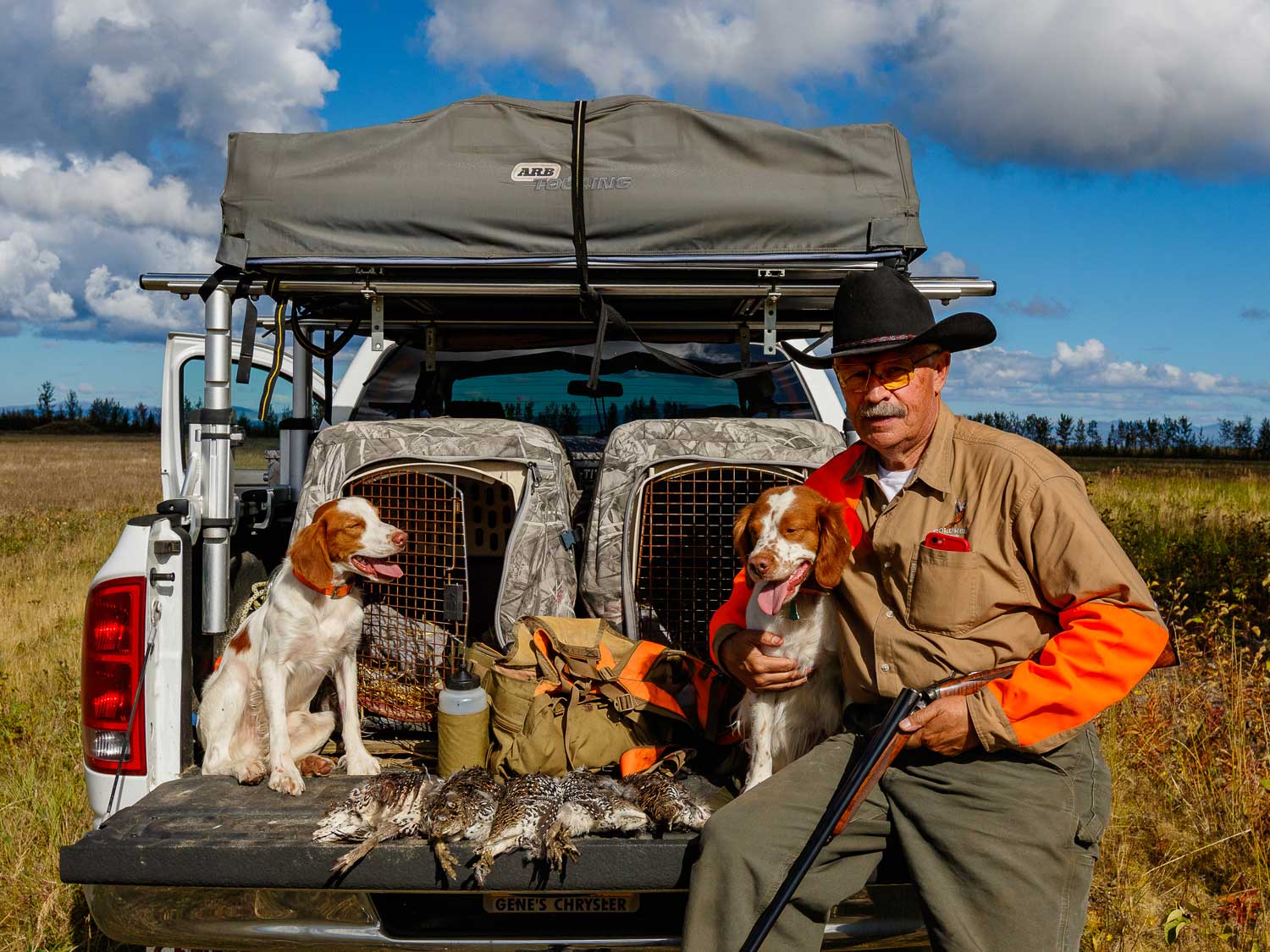
“Because of the frigid temperatures I needed to get the dog boxes off of the metal bed. I built a frame out of marine plywood, fill the boxes with straw, and throw an Arctic Shield Kennel Cover over the top. Above the kennels is an ARB rooftop tent and rain fly mounted on an adjustable Thule rack. I sleep in a flannel-lined bag rated to below zero temperatures on top of a three-inch, closed-cell foam mattress. The dogs and I stay perfectly warm in even the coldest Alaskan temperatures. Everyone needs to have an indulgence and mine is a PETT portable camp toilet. After 50 years of hunting in Alaska, I’ve learned that one can never be too comfortable in the woods.”
The Bird Bus
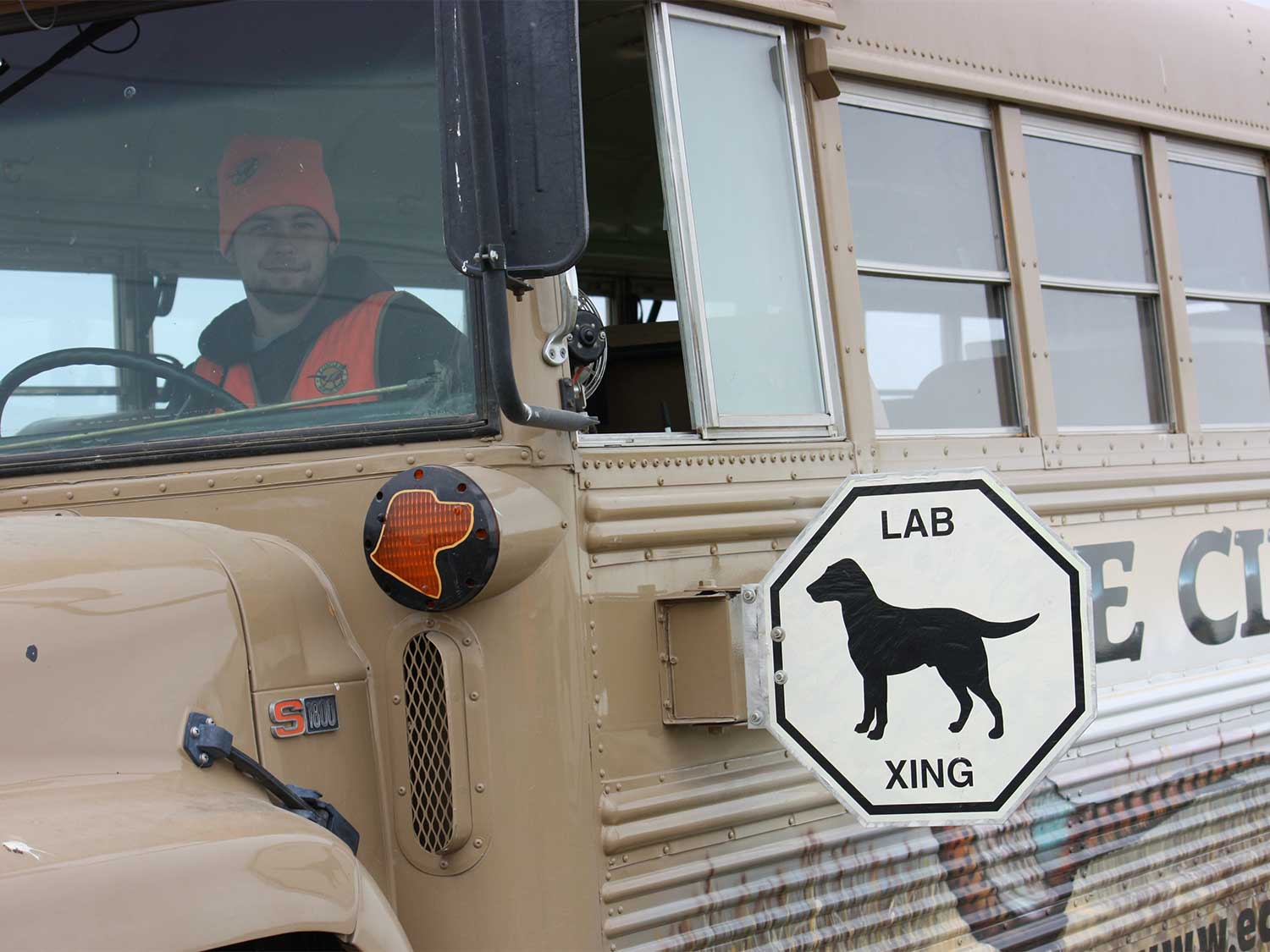
Bob Emmick, the former owner of South Dakota’s E Circle E Hunting Farms, used an approach similar to many commercial pheasant hunting operations: a retired school bus. “School buses make for perfect vehicles to transport large groups,” he says. “The birds are in flat fields full of soybeans, silage corn, wheat and rye, so four-wheel drive isn’t essential. Capacity is, and on our larger drives we accommodate up to a dozen hunters. Add in blockers who stand behind round bales at the end of the field along with a few guides and dogs, and we’ve got a lot to transport. Retired school buses are the perfect solution.
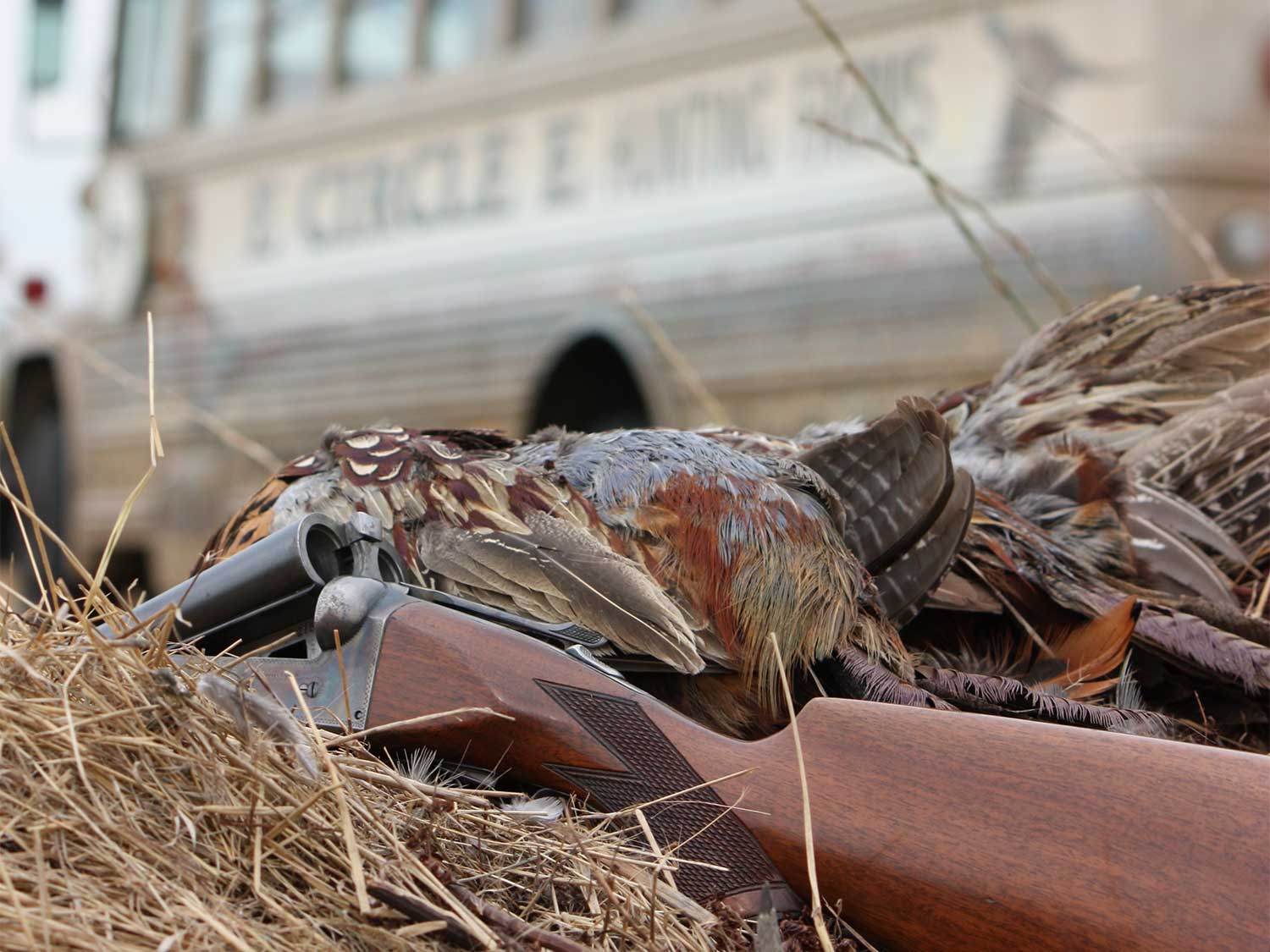
“Not much customization is necessary. In one of our buses, we removed a few rows of benches in the back of the bus,” Emmick says. “We installed stacked kennels to accommodate our labs and added two five-gallon water jugs with spigots. The dogs are released through the rear door which keeps them separate from hunters and helps them access water during a break. Gun racks were screwed in above the windows to keep shotguns safe during transportation. In the center of the bus, we replaced one of the rows of seats with tables, perfect for coffee on a cold day or a mid-day lunch. Guests love the few finishing touches we added like the lab crossing sign and the lab directionals. The painted mural is fun, too.”
Texas Top Drive
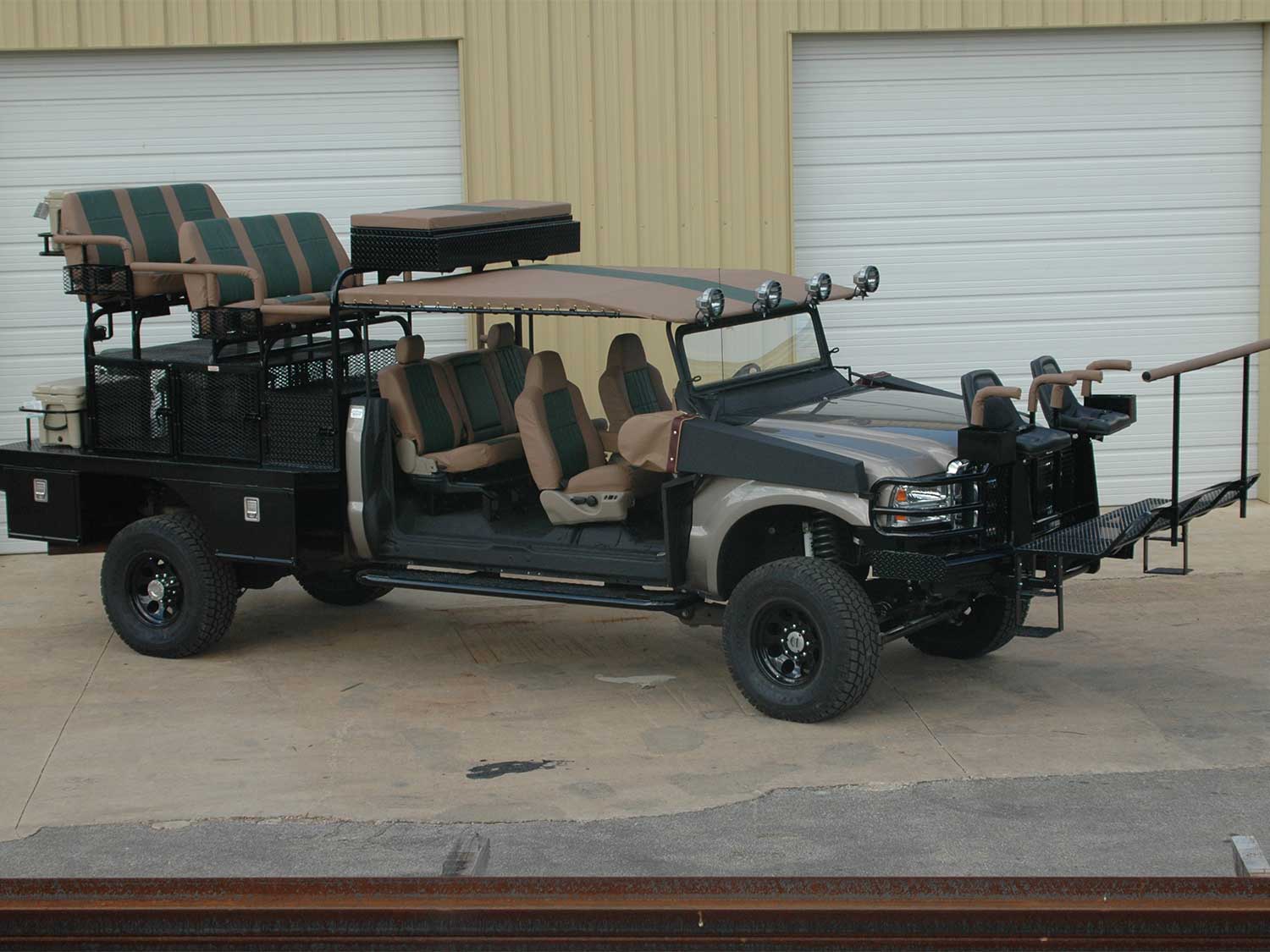
About two decades ago, Jay Robertson bought a new truck that he wanted to trick out for South Texas whitetail hunting. He went into an accessory-focused shop in San Antonio called South Texas Outfitters, and the next thing he knew, he bought the business. “Buying that truck was either the best thing I did or the worst,” he says. “But in all seriousness, I’ve been a life-long hunter, and the opportunity to create solutions-based vehicles for hunters of all types has been a lot of fun. Every project is unique. Sometimes we’ll extend frames and lengthen bodies to turn a two-door Jeep Wrangler into a four- or six-door version while other times we’ll build bird buggies for South Texas quail hunting. We meet with owners, evaluate their vehicles, and create a plan to suit their needs.
“One common South Texas whitetail rig is the top drive. Whitetail sneak around in the six- to eight-foot-tall brush, so ground blinds and still hunting can be tough. There aren’t a lot of trees big enough to hold a stand while providing a view, so the top drive vehicle solves that issue. It’s a mobile blind that can start with any full-sized truck or SUV. A Ford Super Duty is in the picture. I beefed up the rear suspension to hold the extra weight and then built a steel platform. To inhibit rust, I added a combined powder coat primer covered by an overlay of sprayed bed liner. Climb a ladder to get into the steel-framed canvas blind. On a sunny day, hunters appreciate the canopy which is removable. Swivel chairs, benches, gun racks, gear boxes, and coolers are standard options and complete the build.
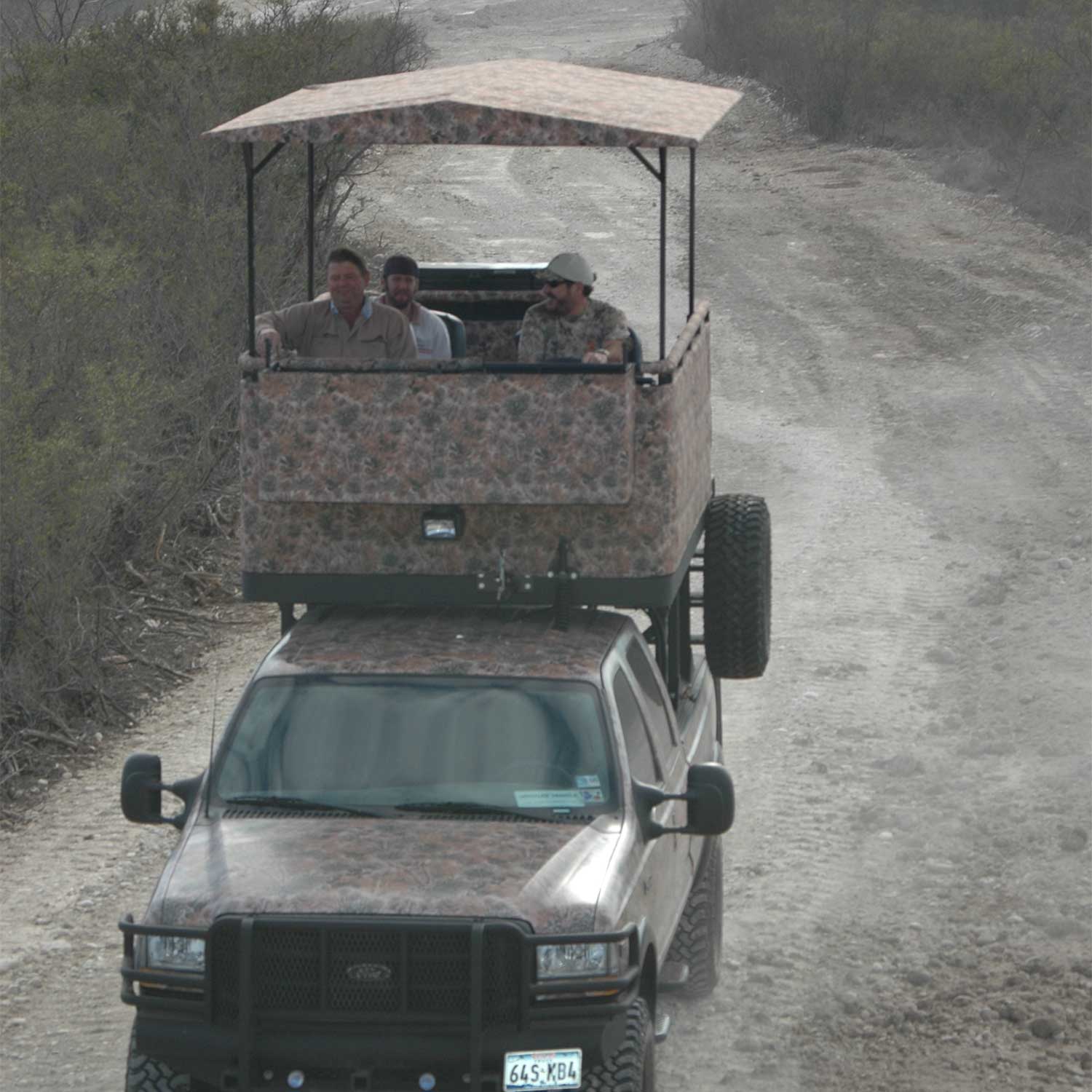
“The biggest draw is the top drive function. It’s like running a boat from the bridge and is easily done by connecting a steering wheel directly to the main wheel. Shifters run to the gearbox, and speed is controlled by a throttle connected to the gas pedal. Right now we’re working on a Ford F-650 that is our most ambitious top drive to date. The platform is an enormous 23×10 feet, and that 230 square feet is spaced for couches and a cooking area. There is a flatscreen TV with thermal imaging that shows the group what the hunter sees through his scope.
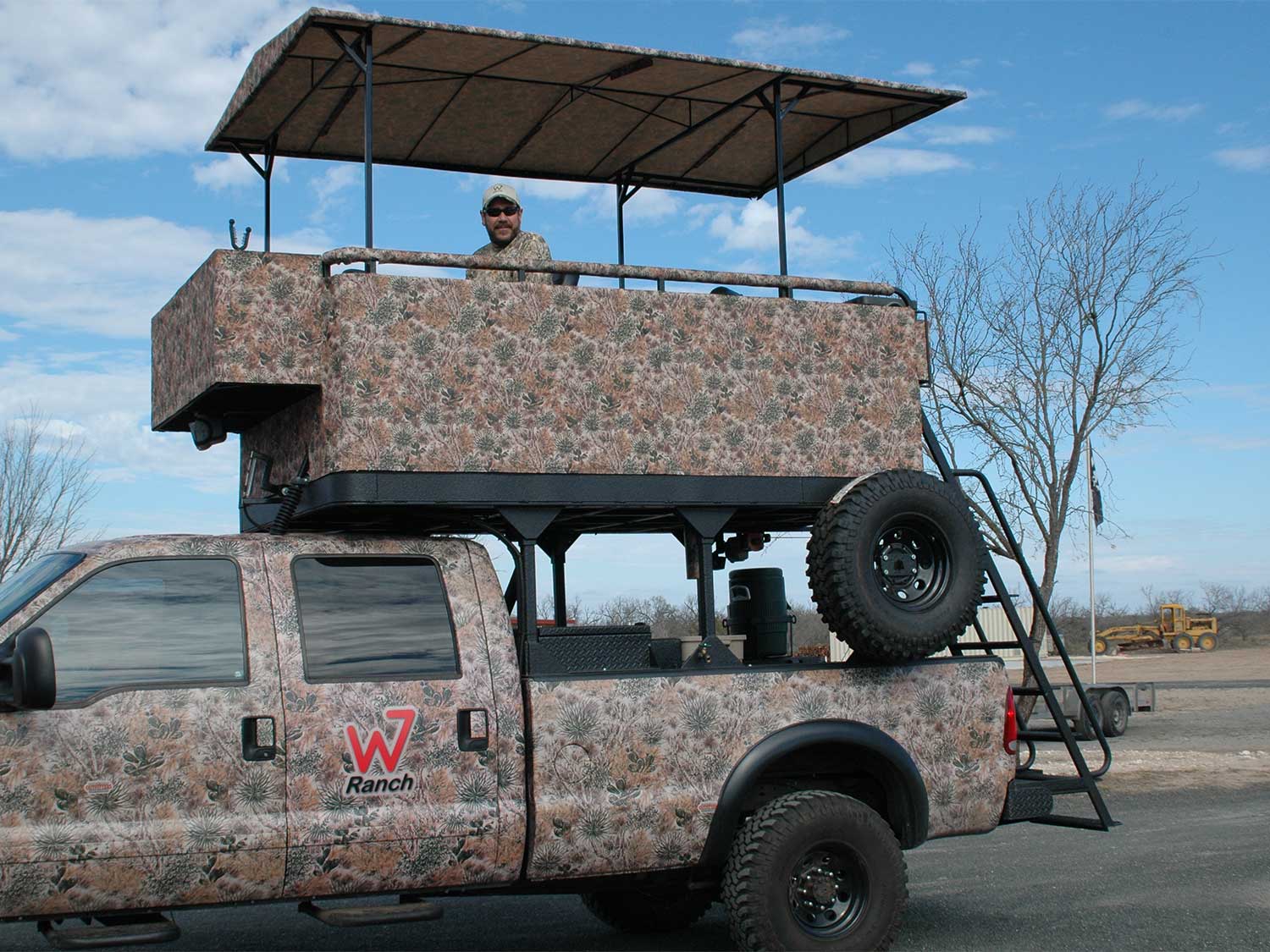
“Safety is our number one concern when building out our vehicles. And since I love to archery hunt in Colorado for high-alpine elk, I wonder if I can build a vehicle to replace my horses and mules.”
One Sweet Rig
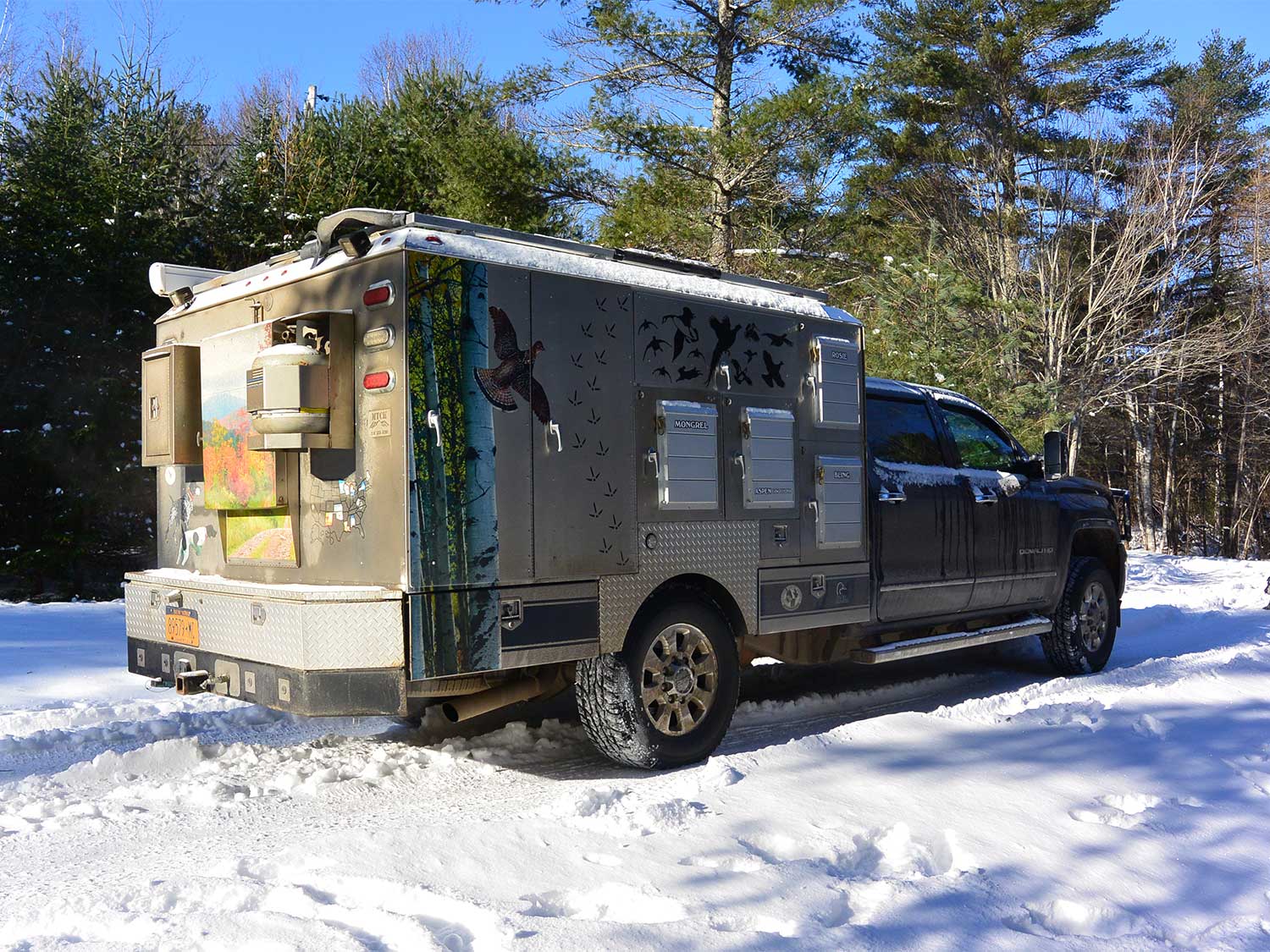
Versatile hunting dogs come by their name honestly. They basically go anywhere and do anything. What’s better than running your shorthair on a morning waterfowl hunt, followed by a mid-day rabbit hunt, then an afternoon bird hunt? Not much until you need to swap waders for chaps and camo for orange. And when you multiply that gear list by your four hunting buddies and put it all in one truck, you get a cluster ruckus. One day David Kuritzky had enough.
“I knew there had to be a better way, so I set about creating a specialty rig for hunting and training,” Kuritzky says. “I started with a GMC Sierra 3500 HD which featured an eight-foot bed and an extended wheelbase. I removed the bed and then custom-designed a top with Mountaintop Custom Kennels in Abington, Virginia. Dogs are the centerpiece of my hunts, so I started with four kennels on each side. The boxes are insulated and have ventilated louvers on the doors. These vents offer good ventilation on hot days and retain heat when it’s cold. Freshwater is critical, so I added a 35-gallon reservoir that is gravity fed for easy pouring. I carry a 12-volt pump that pressurizes the water to hose down dogs or muddy gear. The back of the truck has an easily-accessible box loaded with medical supplies. A removable stainless steel table is invaluable for emergency dog care, serving meals, or holding gear.
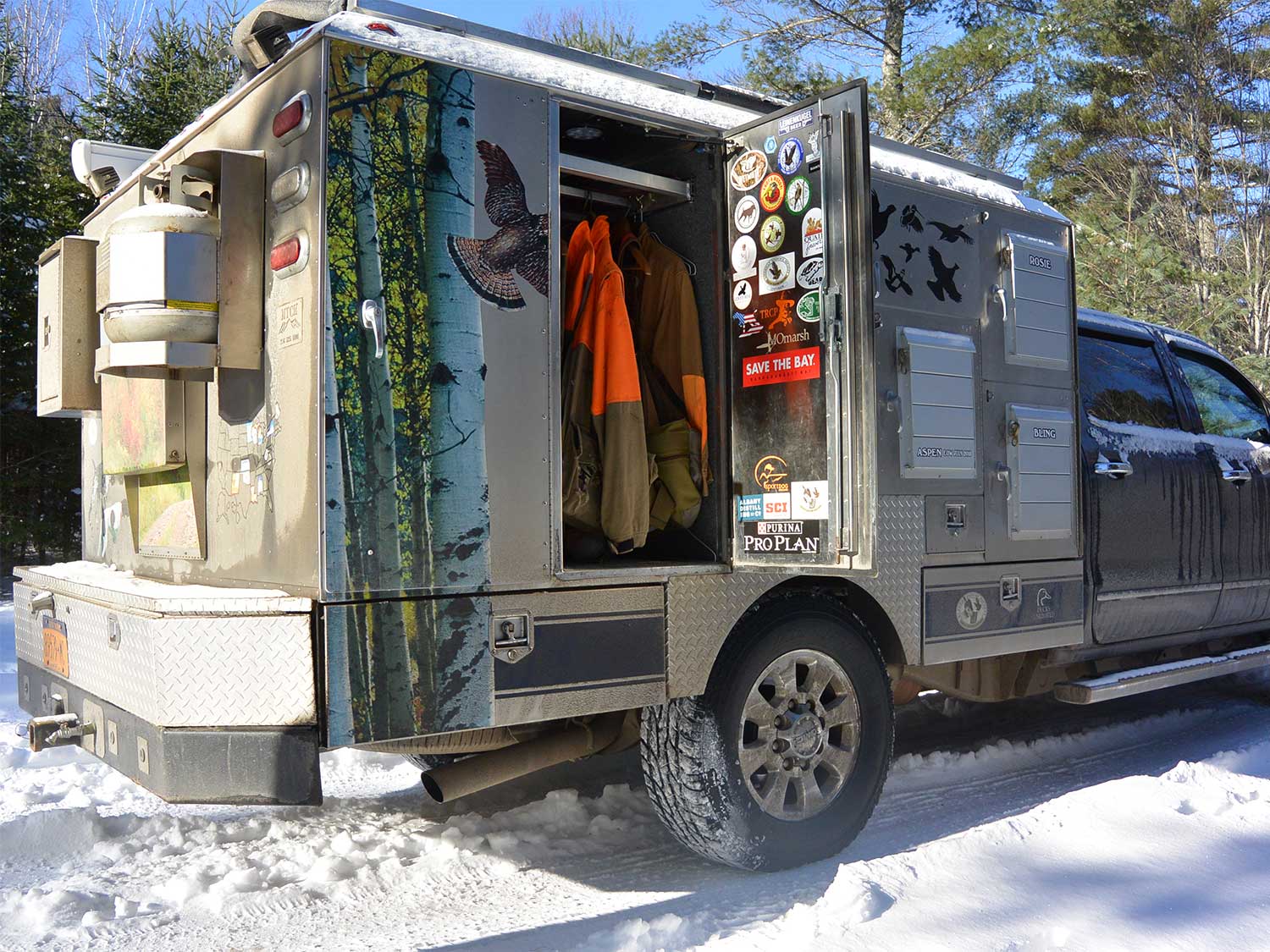
“One of my goals has been to hunt different species of game throughout the United States. Meal preparation along the way is important, and I added a propane tank and a T-connection which runs to both a propane stove and griddle. I can cook harvested game for a midday lunch just as easily as steaks for dinner. To increase time in the field, I installed an inverter for slow cooking. The smell of barbecue wafting through the rig makes every toll booth collector think about lunch.
“Accessing gear was the final build out. I built a cabinet with a pull-out rack that makes the selection of camo or orange, waders or boots a breeze. All I have to do is open the door or pull out the drawer. Staying dry is important, so I added a pull-down awning. It keeps the rain and snow off of us when we’re changing just as it keeps the sun from beating down when we have a tailgate lunch.
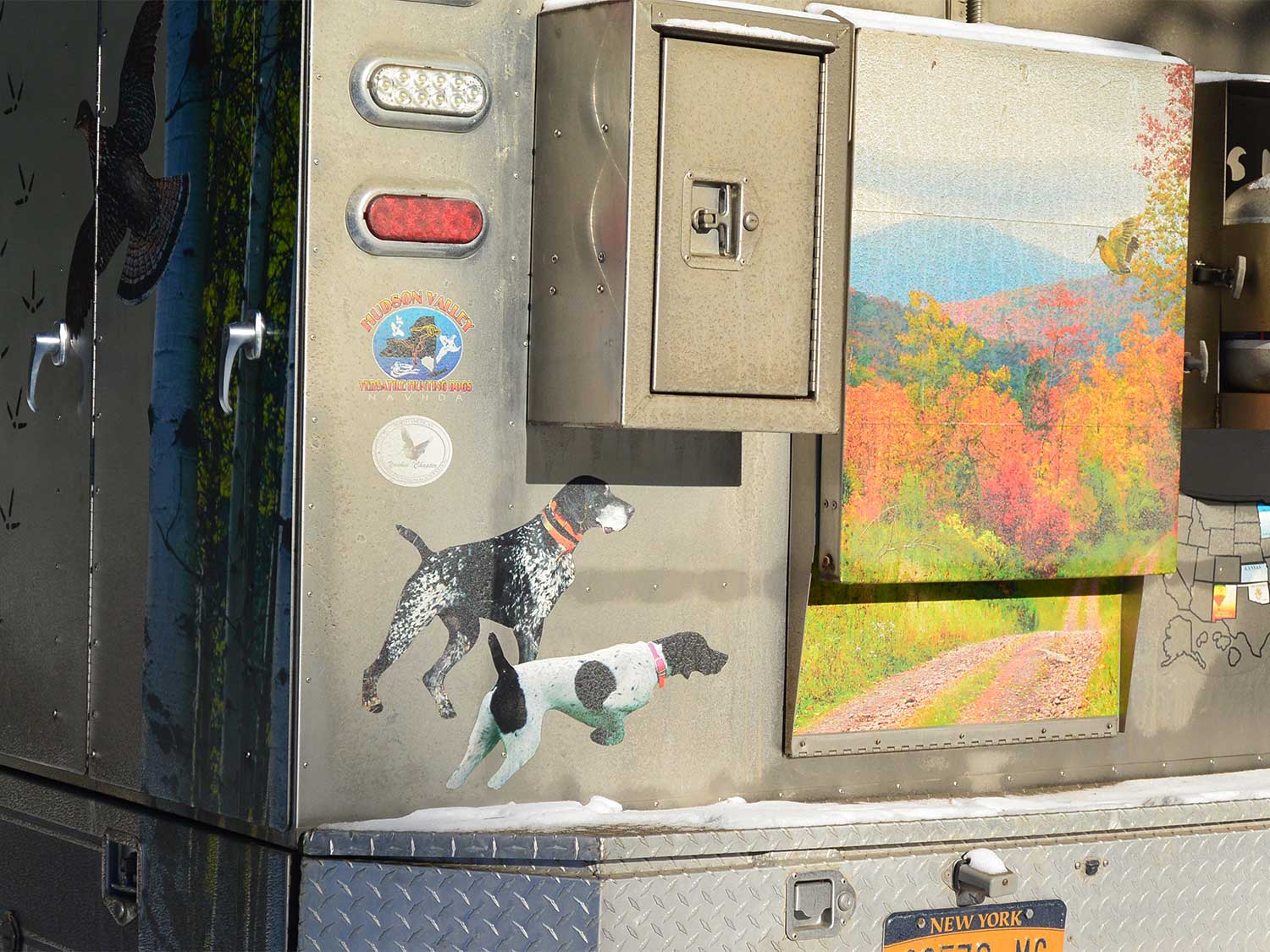
“Hunting rigs should be fun, and that’s why I added art to the sides. The rabbits, waterfowl and upland birds are represented through simple line drawings while a color mural shows the terrain in which we hunt. A map of the country highlights each of the states in which I’ve successfully hunted game, while logos reflect the conservation groups I support. Every truck needs a name, and we all call mine ‘Sweet Rig.’ I put 100,000 miles on it, and the only recent addition is a winch. An 11,000-pound vehicle can bog down in a muddy road, and since AAA doesn’t make back-woods house calls, I’ve got to be self-sufficient.”
The Bird Buggy
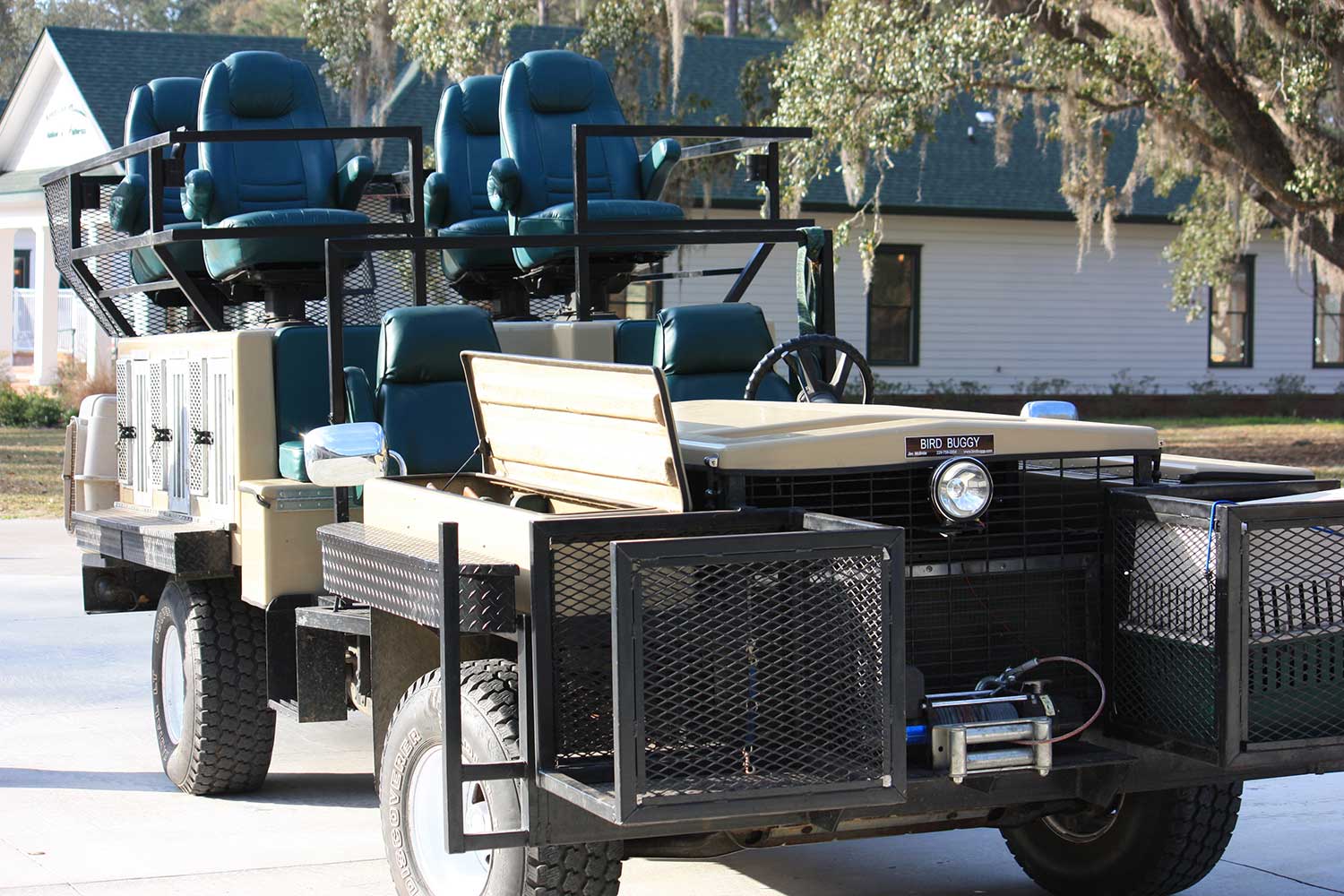
Bob Williamson is a meticulous man, and when he opened his plantation to the public for hunting and fishing, he left no detail unnoticed. That included his hunting vehicles. “I love the nostalgia of a mule-drawn wagon, but they aren’t exactly a comfortable ride,” he says. “Folks don’t like to get beat up when driving down a dirt road following two braces of English pointers. Easy access for handlers and hunters is key, so I built a rig to my specific requirements.
“I first started with a Chevy Suburban engine and frame. I built a steel frame with three purposes in mind. First, I wanted a bench seat a few steps up from the ground, so older hunters had an easy time getting off the buggy and up to a point. The second part was to offer a higher platform for additional hunters who wanted to watch the working dogs. Quail hunting is about the dogs, so the third part houses six dog boxes, three per side, that are under the elevated seating area. I’m a fan of English cocker spaniels, so two cages off of the front hold small crates.
“All that remained was a safe, protective gun rack. Some of our guests shoot fine shotguns, so a hinged-lid that holds three foam-lined racks covered with velvet keeps dust and scratches away. Add in a cooler with drinks for hunters and a few water buckets for dogs, and all travel comfortably and in style. No one needs to see a chiropractor after a hunt, either.”
The Duck Truck
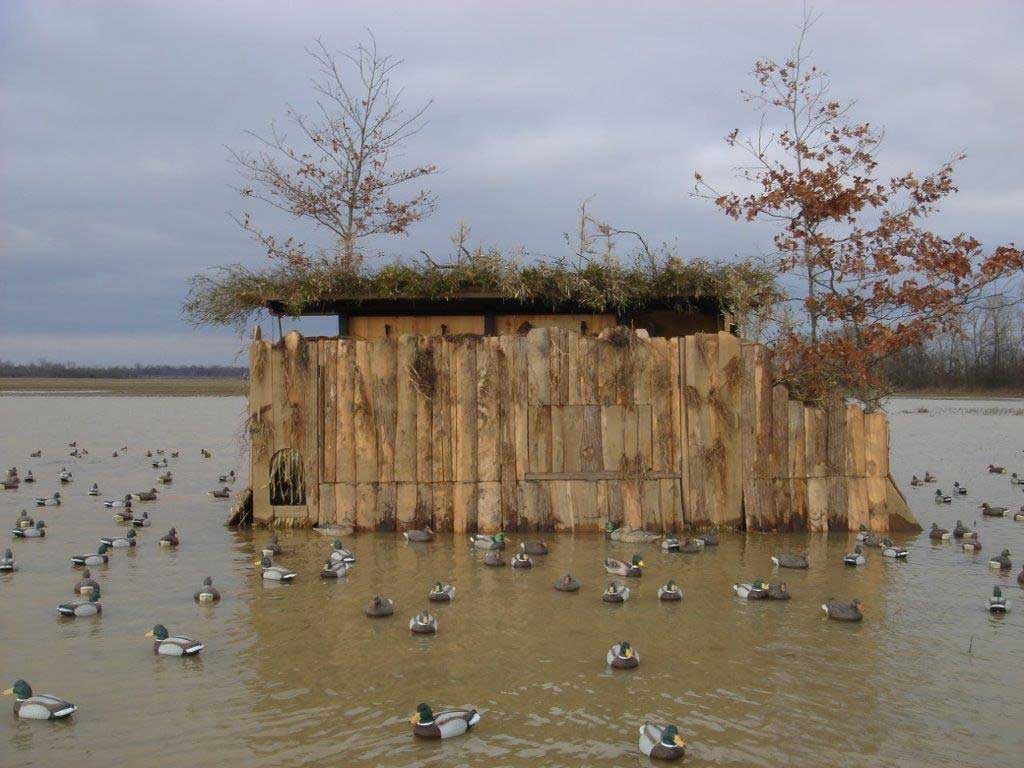
How many construction managers does it take to screw in a lightbulb? If you’re Arkansas’ Marc Dillard, the answer is one. Dillard created the Duck Truck that will make even the most seasoned waterfowler smile.
Dillard stripped down a 1978 F-250 extended cab with an 8-foot bed. The 460-cubic-inch engine had plenty of horsepower to plow through mud and water. Since breaking down in a marsh is never a good idea, Dillard opted for a pre-computerized vintage that he can work on himself. As water and electricity never go well together, he re-engineered the wires and gauges, so they are sealed and waterproof. 35-inch Super Swamper tires make slogging through muddy fields and shallow potholes a breeze.
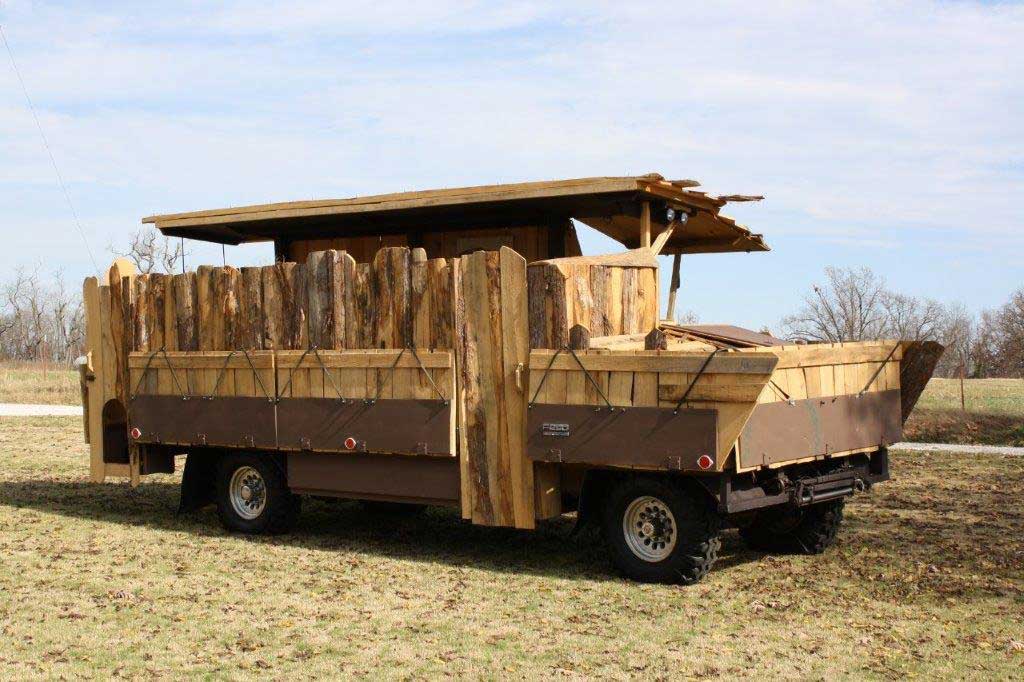
To accommodate hunters, dogs, and gear, Dillard welded an additional two feet of steel to the frame. He then added a steel base with posts and framed it like a pit blind. “The Duck Truck is not street legal,” says Dillard. “It’s basically a blind on wheels. I tow it behind my truck, and when I get to my hunting spot, I unhitch it from the tow bar. I’ll run about 15 or so miles per hour on the dirt roads, and slower in the fields and marshes. I’d hate to think about how many miles per gallon it gets.”
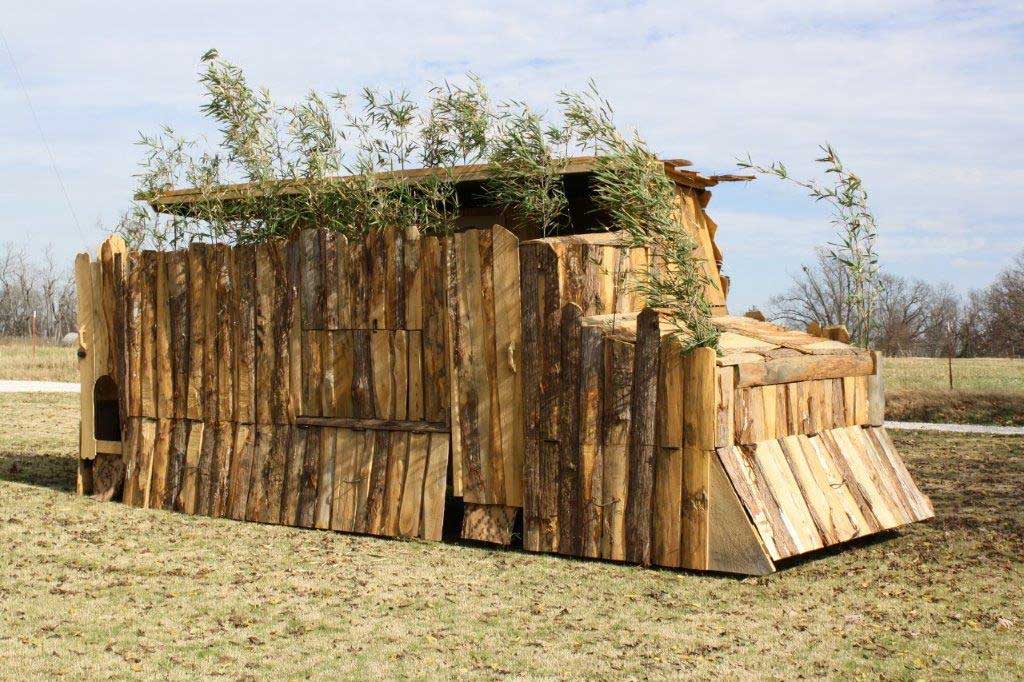
For camouflage, Dillard added locally-sourced, scrap cypress. The bumper and wheels have hinged sheets of plywood and cypress that drop down once the truck is positioned. He has strategically added entire trees to the rig. To keep motion decoys from running out of juice, he hard-wired the dekes to the truck’s battery. “I went so far as to add a timer to each motion decoy,” Dillard says. “Timers are set so when the first decoy stops, the next one starts. It goes right on down the line, so one duck is never in motion all the time. That sequence makes my setup look more natural, and we kill one heck of a lot of ducks.”
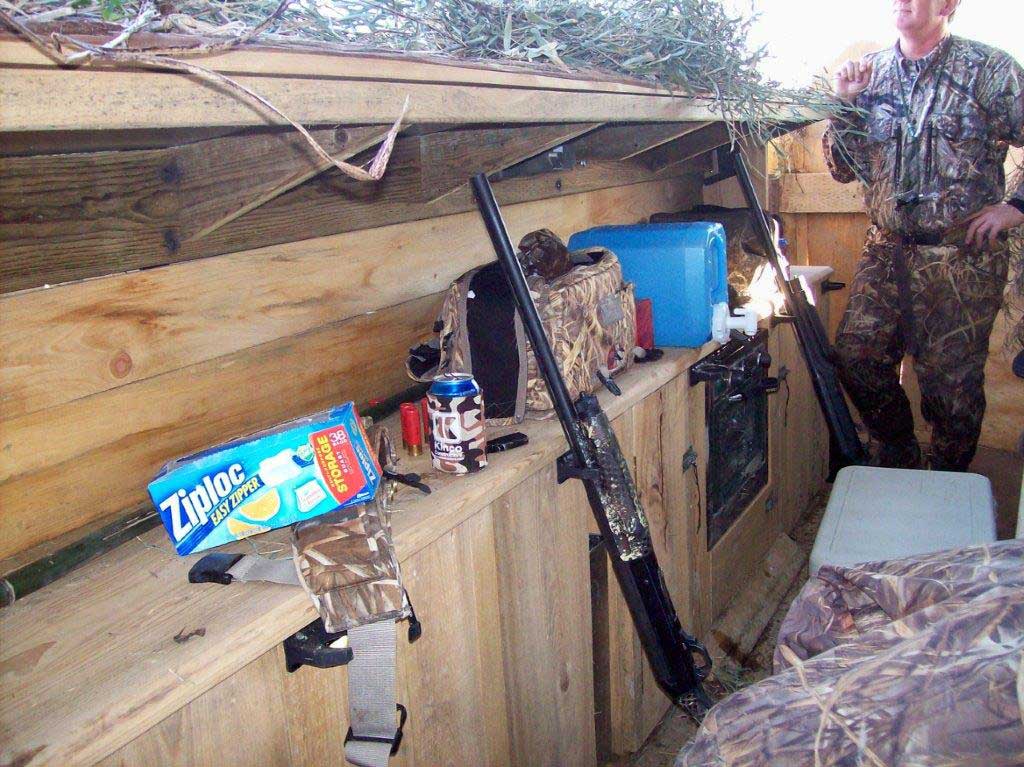
There is no joy in being wet and cold, and the Duck Truck keeps everyone comfortable, even the dogs. There are ramps for labs exiting on a retrieve and a kitchen with a stove to whip up breakfast and lunch A gas-fired propane heater keeps the hunters warm on frigid days, and during a downpour, a weatherproof tarp roof keeps everybody dry. There are also gun racks and a bench that gives the hunters a perfect view of circling ducks.
“I have rope lights inside the blind making it easy for my buddies and me to find shells, calls or gloves,” Dillard says. “On the inside, it looks like Baum-Walker Stadium during a night game. The light is contained, so the ducks never see it. I did run rope lights on the outside, and they’re invaluable when we’re setting a spread well before sun up.” Half of the blind doubles as a decoy rack for 20-dozen decoys.
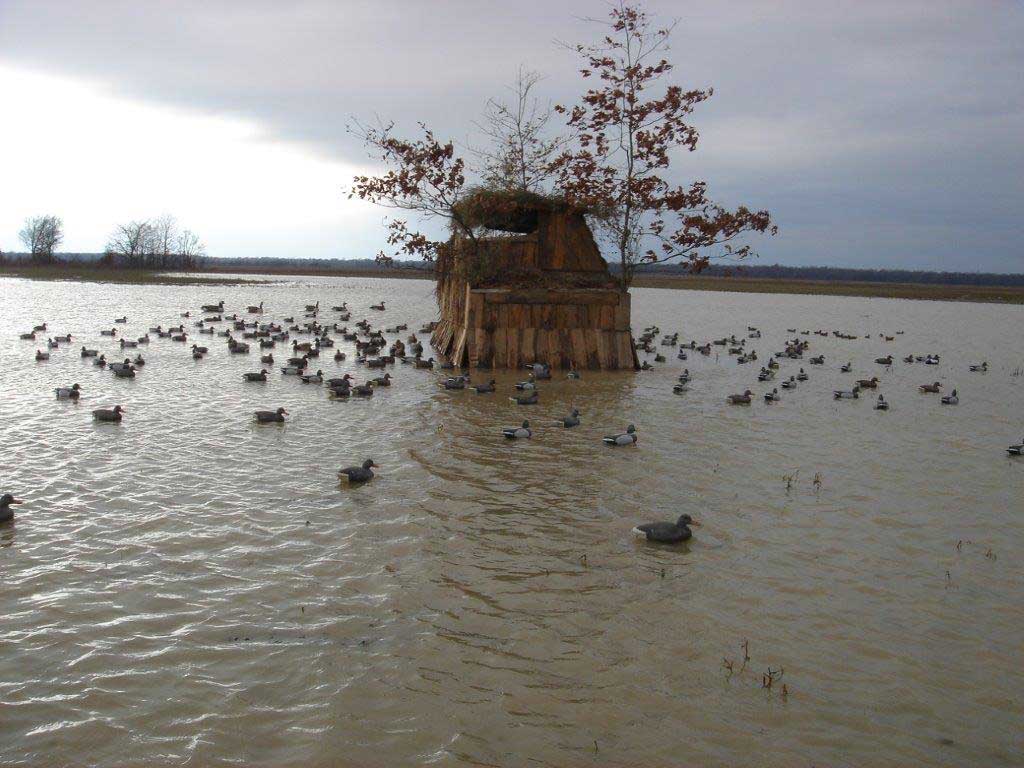
“I’ve been duck hunting my whole life, and as the former State Chairman of the conservation-forward Delta Waterfowl, I’ve hunted with a lot of buddies,” he says. “We’ve all sat on milk cartons in blinds and roughed it in marshes, fields and rivers. With some help from my brother Mike and a good friend Richard Stewart, I’ve solved most of the waterfowling problems. We simply relocate to where the birds are, our setups are quick and easy, and we hunt in comfort. If you think the Duck Truck is cool, you should see my duck boat.”
Stuffer Sanctuary
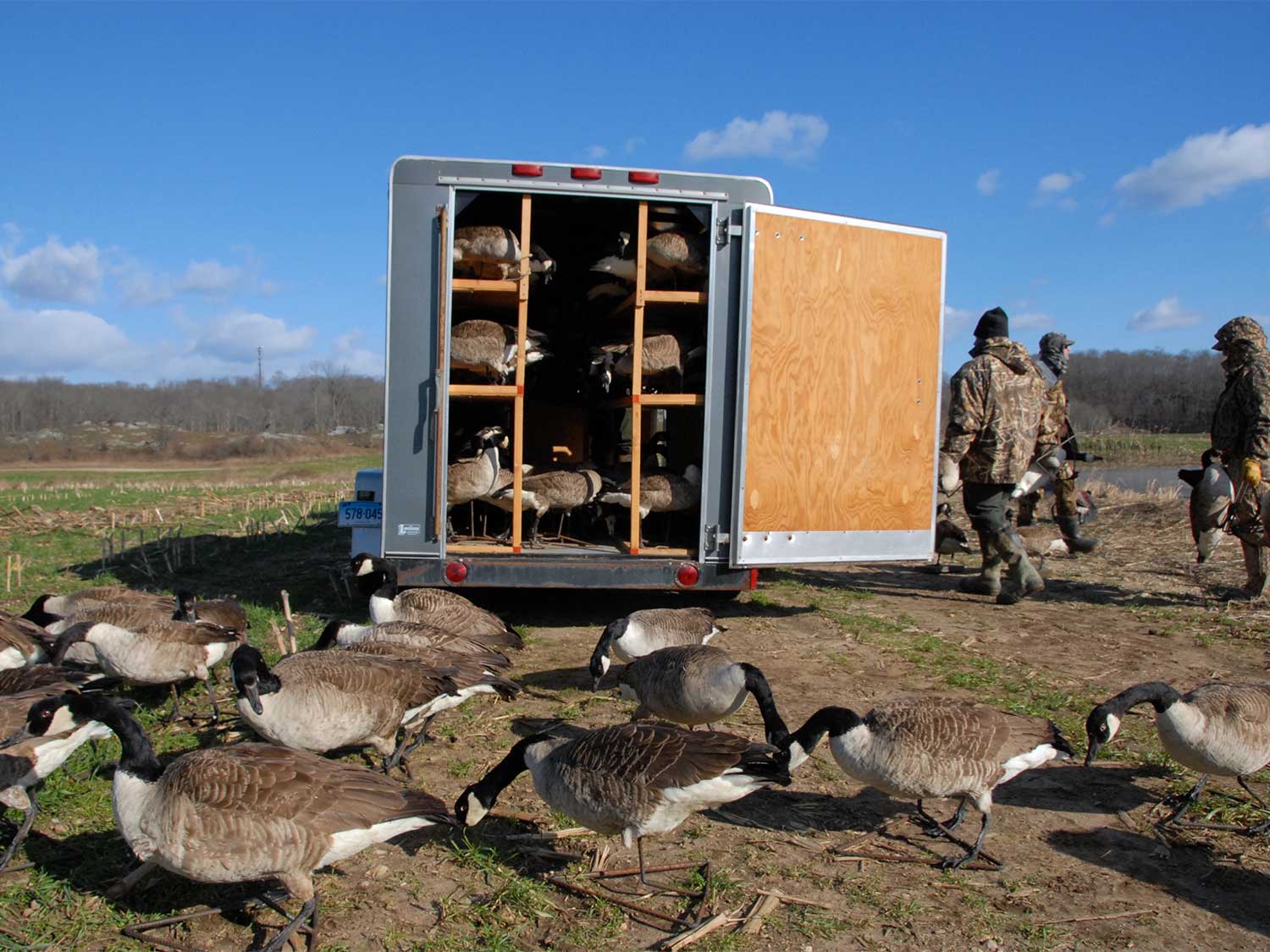
Late season geese can be wary. Add sun shining down on a snow-covered field of winter rye, and you’ve got a glare that makes plastic dekes look unnatural. To solve that problem, Captain Dan Wood borrowed an idea popularized by Eastern Shore goose hunters in Maryland from the golden age of waterfowling. He created a spread of stuffer decoys.
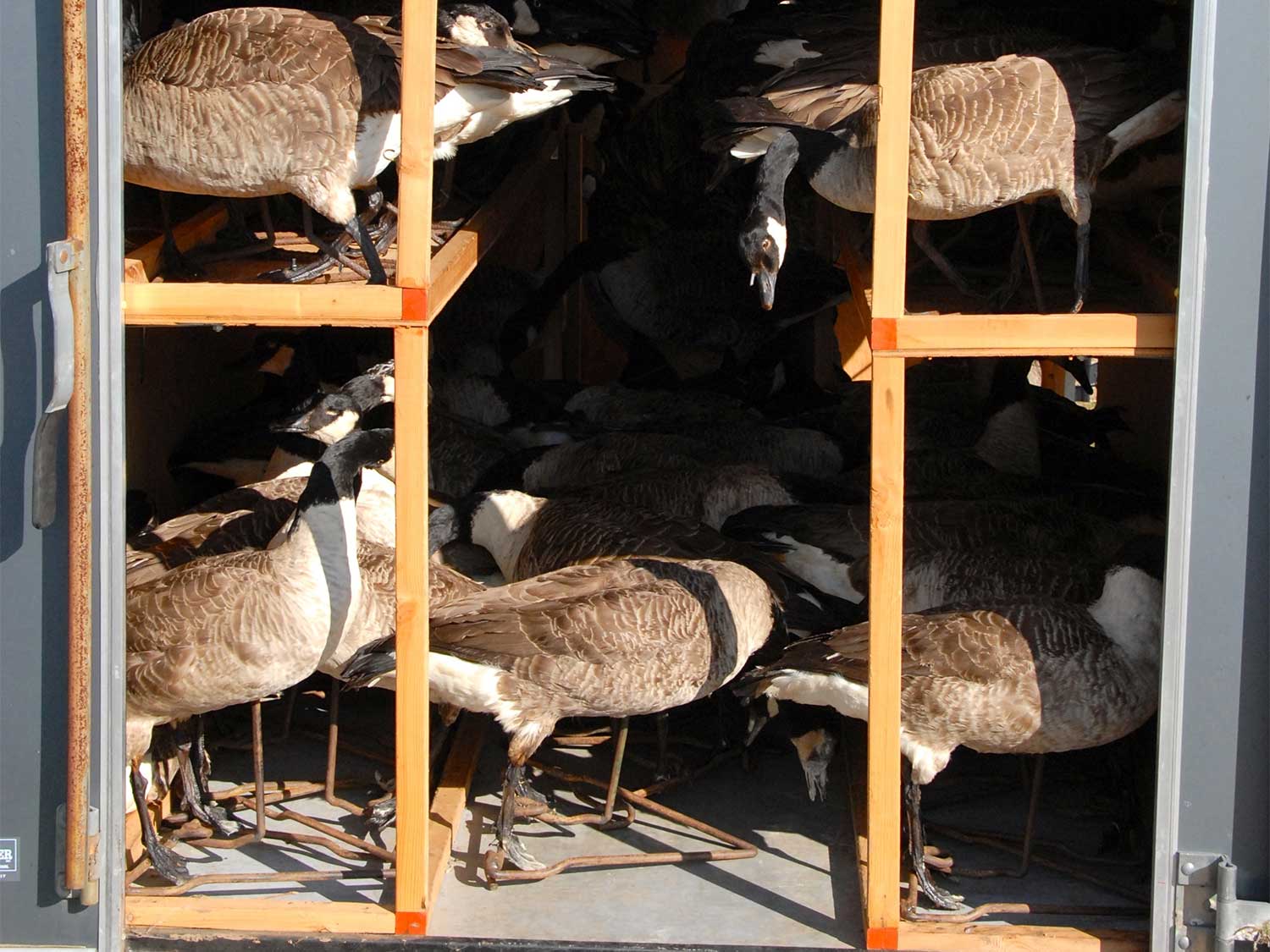
“There isn’t anything like hunting over stuffer decoys,” Wood says. “Their feathers naturally absorb the light and blow realistically in even a slight breeze. A big spread sucks in geese that have become call-shy during the late season. My stuffers are skin mounts over foam bodies, with a variety of sentinel, feeder, and active heads. So they don’t blow over, I mounted them on a triangular base of scrap rebar. I got a little carried away with the process and wound up with 110 of them.”
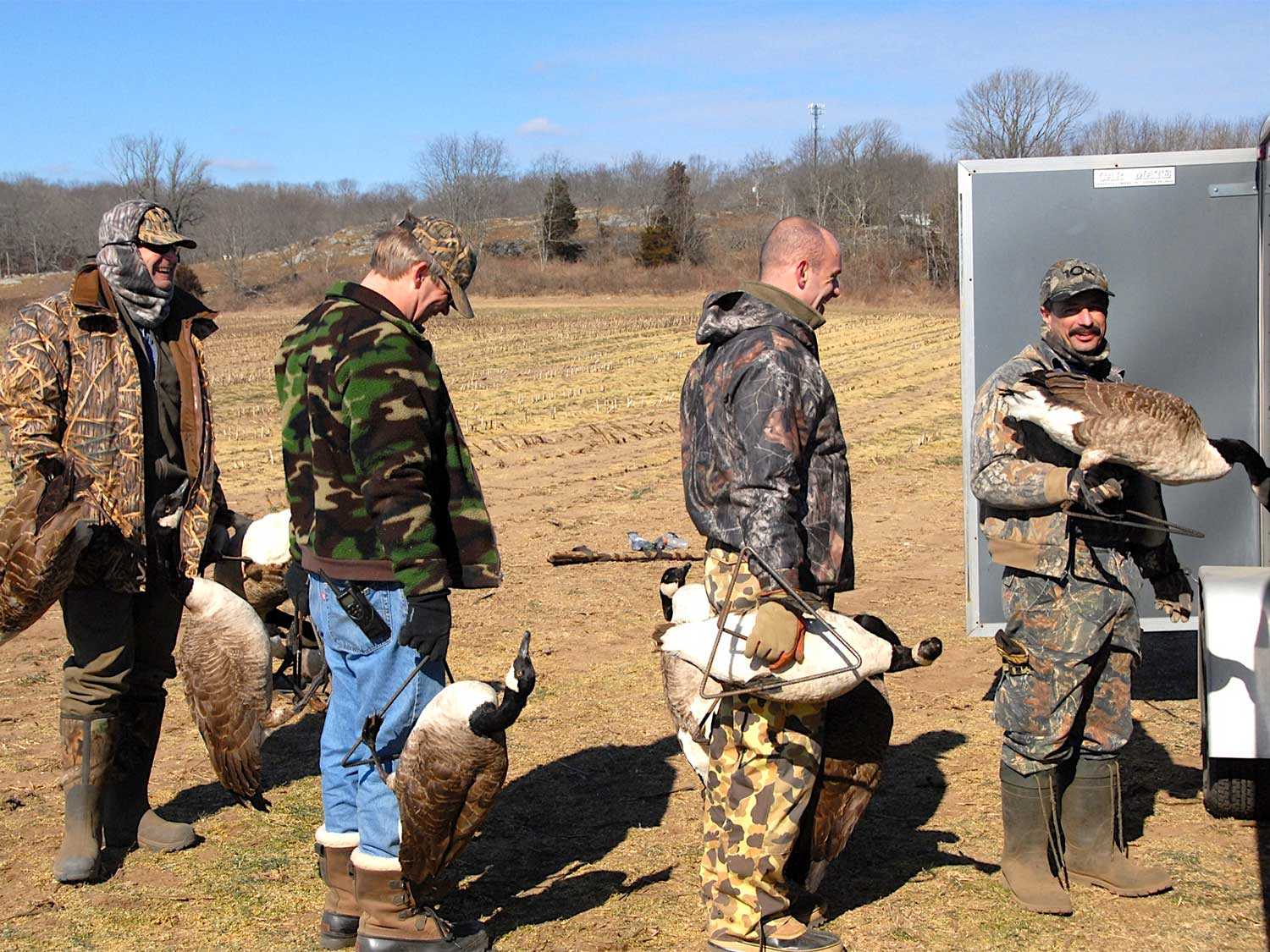
“The only downside is, I can’t toss ’em in the back of my pick up as I do with plastic dekes,” he says. “After half a year’s worth of taxidermy I wanted them to last, so I built a trailer. A 14-foot Car Mate utility trailer commonly used by contractors is perfect as it’s enclosed and weatherproof. I lined the walls with foam to keep the decoys from getting banged up while bouncing down dirt roads and built shelves of sheet plywood on top of a 2×2 frame. The racks are set at different heights to accommodate the various head positions, and a 1×3 front lip keeps them from falling out. My final touch is a bungee cord that stretches from the front to the back of the trailer and presses the stuffers against the shelf. My buddies might complain about our ride down a bumpy road, but all of my decoys are safe. And if we ever get pulled over by a state police officer, even the geese are wearing their seat belts.”
The Critter Gitter
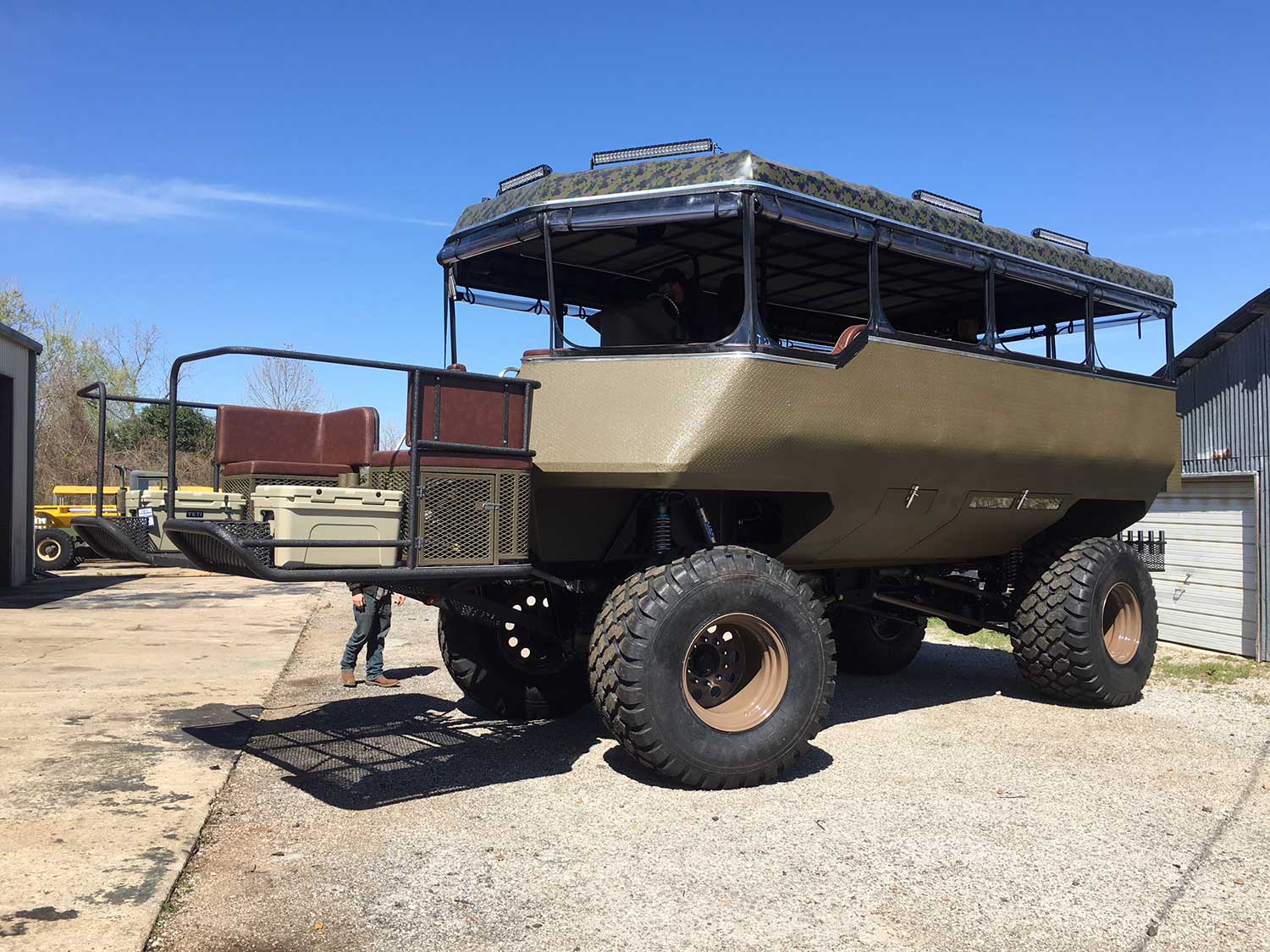
Texas ranches are big and offer a lot of different types of game to hunt. When it came time to build a vehicle that could be used for hunting whitetails, waterfowl, bobwhite quail, hogs, dove, and turkey, Bob Woodcock needed to think outside of the box. That’s how he came up with a vehicle that is also the name of his company: The Critter Gitter.

“My team designs Critter Gitters for the various requirements of ranch life,” he says. “They can be used as a blind for duck, whitetail or hog hunting just as easily as they can be used for hunting quail. The size means that we can bring an entire group of dove hunters to a field or use it for spot and stalk hunting. We build three different sizes, the Mini, the Junior and the Senior. I start with an engine and chassis. Most folks have a favorite truck manufacturer, so Critter Gitters are built with Ford, Dodge, GMC, or Chevy powertrains. The Mini in the picture has a Ram Jet 502cid engine with an automatic transmission and four-link suspension. It’s got a 13-foot wheelbase and 2-½-ton axles to support the overall weight. To drive through a marsh you need big tires, so these are 48×25 inches.
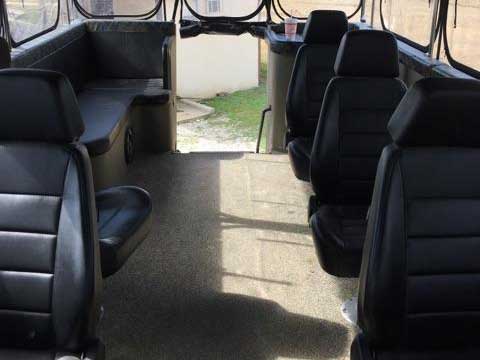
“The body is made from aluminum, but to create durability for rough riding, we mount it on a steel frame and substructure. We can add hard tops if customers prefer, but most hunters like air circulating through an actuated, adjustable canopy top and full curtain enclosures. There are belly-mounted dog kennels, gun racks and scabbards, LED lighting, heaters for cool mornings, and quail seats. To get into a rig that is so high off the ground, we added folding stairs in the rear. The full wet bar is a nice touch for after the hunt. We’ve been building a variety of custom hunting rigs for over 30 years, and have even shipped several Critter Gitters overseas.”
If your hunting needs require a lower budget and increased maneuverability, Woodcock and his team also build out Critter Gitter UTVs
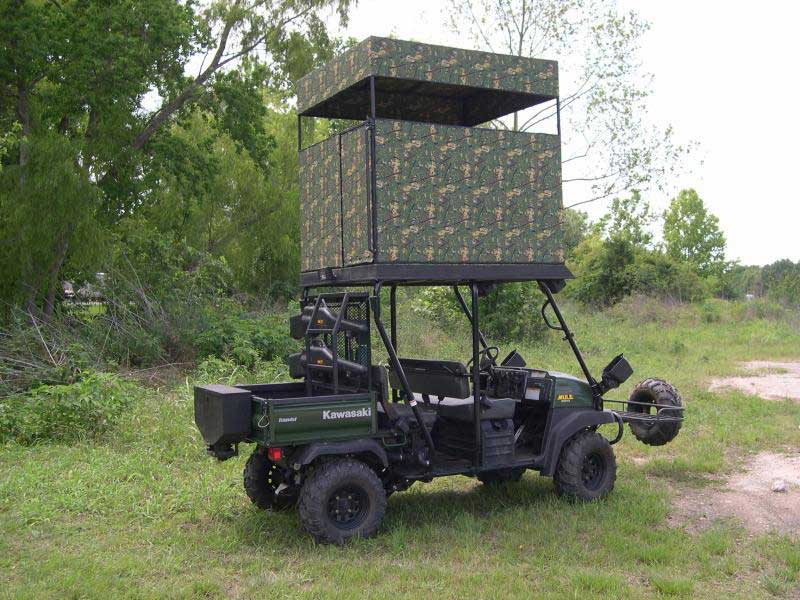
“Sometimes our team works on UTV quail wagons that are custom built to accommodate dog boxes, watering systems, and shotgun scabbards,” says Woodcock. “Other times we expand frames to accommodate blinds for between one and three hunters. Whitetail and hog hunters love them, and waterfowlers do as well. UTV’s aren’t built out with the kinds of details used in trucks, but for many hunters, they are an excellent way to go.”
Southern Comfort
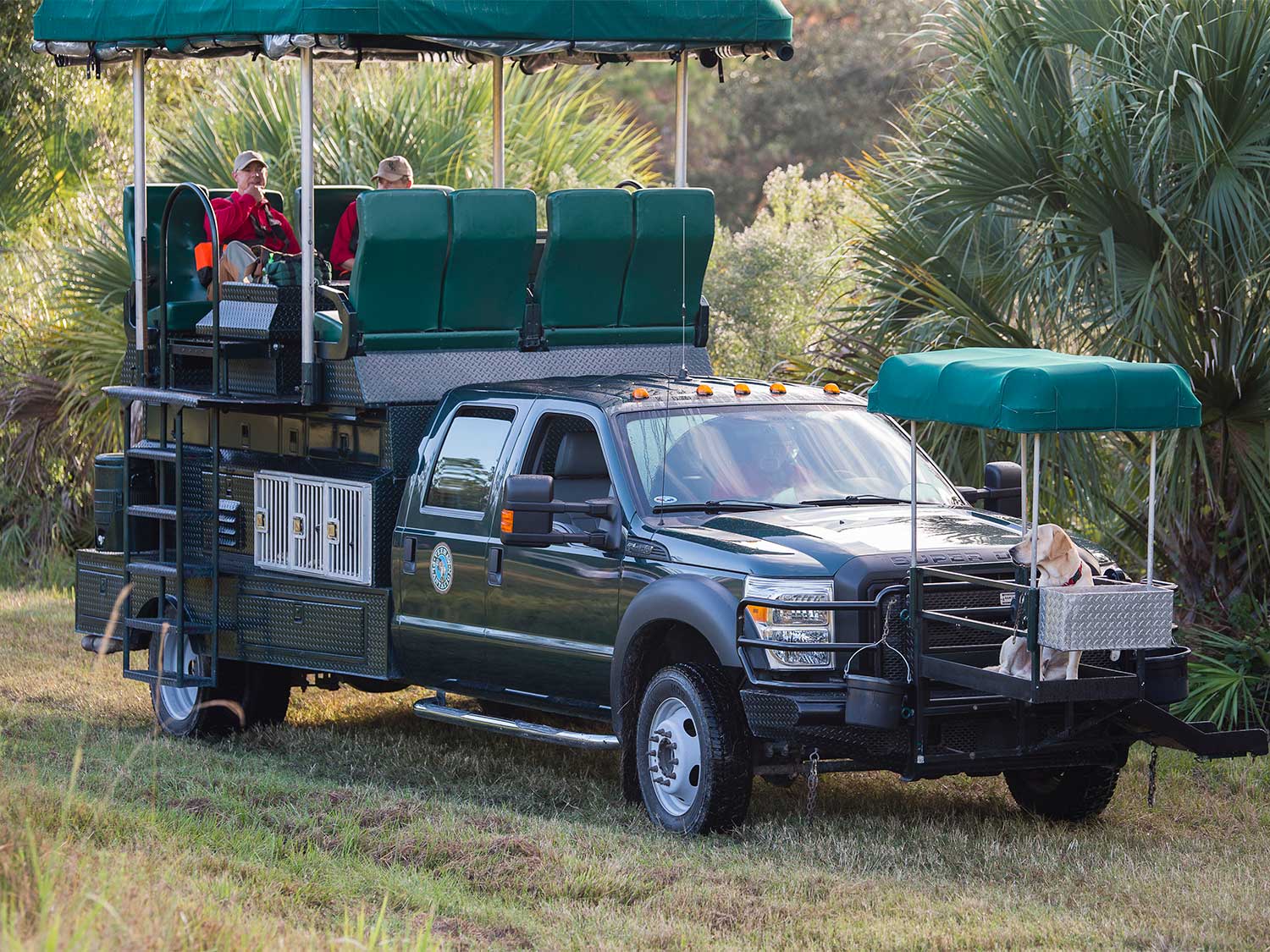
If breeding dogs is your passion, then it’s likely you’ll build a hunting rig around their proper care. At Blue Cypress Kennels in Florida, the team did just that when they created their version of a quail-hunting truck. While no details were spared for their champion UK Labs and English pointers, they added a few details for hunters, too.
“Most of the time I’m riding out front on a walking horse, but when I return to the truck I’ve got everything I need,” Head Trainer Jeremy Criscoe says. “We started with a 2016 Ford F-350 extended cab and lengthened the frame to 33 feet. That extra length accommodates more dog boxes, with five kennels per side. Since we run pointer/flusher combinations, we built a front platform with a short staircase to keep strike dogs handy.
“Hot weather is our biggest obstacle in Florida, and running dogs in those temperatures can be lethal. To safeguard against heat stroke, we added a fan system to each box. That fan circulates air and facilitates cooling. We also added a Lixit watering system. Every dog in every box can get cool water on demand without us having to fill a bowl. With a dozen or more dogs, we need lots of water, so our internal reservoir holds 150 gallons. There also is pressurized water that comes from a spigot, a hose and a nozzle. After a run, I’ll hose off the dogs before loading them up. 150 gallons sounds like a lot of water, but you’d be surprised how fast it is used on a hot day.
“Eight hunters can sit in comfortable seats up top. The seats are heated for use on the few cold days we have. Younger folks climb the ladder on one side while older hunters step on to the elevator on the other side. A canvas canopy keeps the hot sun off of everyone, and on a rainy day, we roll down plastic screens. A carpeted gun rack is on each side, and each accommodates four guns per box. Those boxes also hold ammo and other hunting gear. The final touch is two full boxes for hunter and dog first aid kits. A lot of venomous snakes call Florida their home so handlers can never be too careful.”
